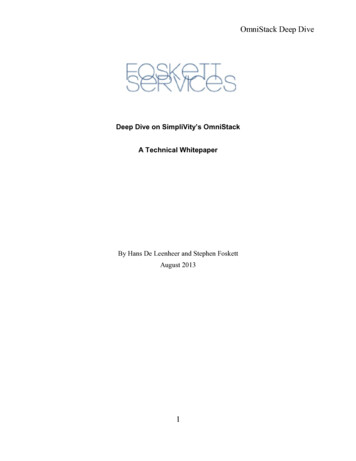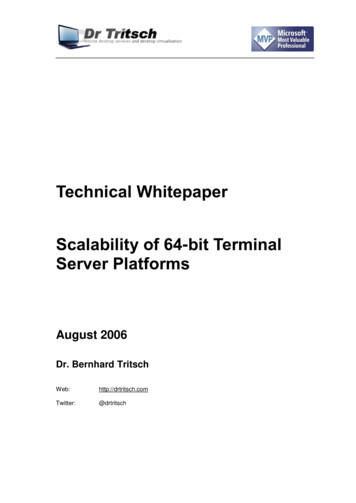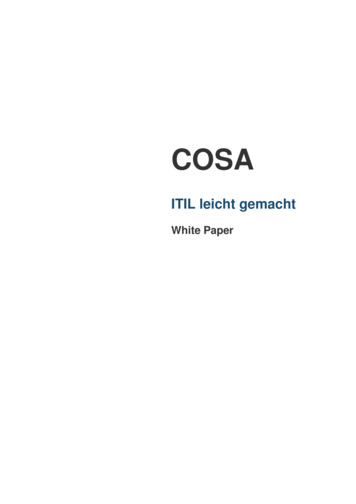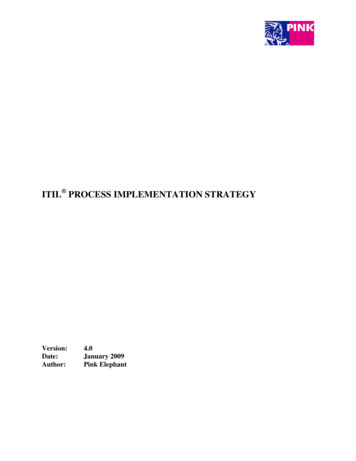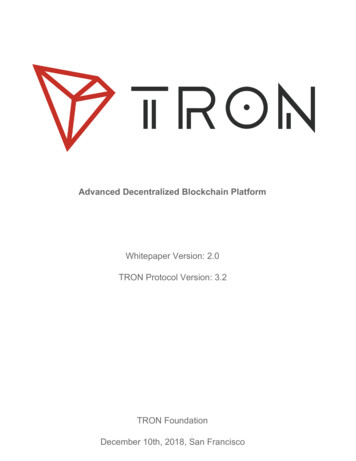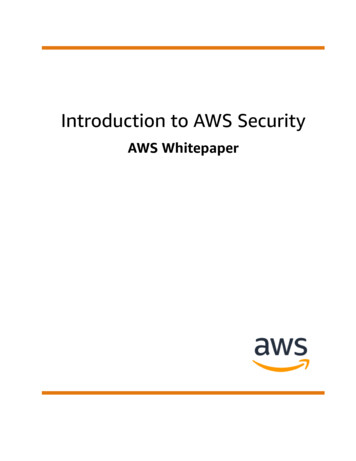
Transcription
The Z ILLIQA Technical Whitepaper[Version 0.1]August 10, 2017The Z ILLIQA Teamm www.zilliqa.com B enquiry@zilliqa.com 7 @zilliqaconsensus and network protocols. Therefore, even though reengineering the parameters of the existing protocols in sayBitcoin or Ethereum (e.g., the block size or the block rate)may show some speedup, to support applications that needprocessing of thousands of Tx/s however requires rethinkingthe underlying protocols from scratch.We present Z ILLIQA— a new blockchain platform that isdesigned to scale in transaction rates. As the number of minersin Z ILLIQA increases, its transaction rates are expected toincrease as well. Specifically, Z ILLIQA’s design allows itstransaction rates to roughly double with every few hundrednodes added to its network. As of this writing, the Ethereummining network is over 30,000 nodes. At Ethereum’s presentcapacity, Z ILLIQA would expect to process about a thousandtimes the transaction rates of Ethereum.Z ILLIQA is a redesign from scratch and has been underresearch and development for over 2 years. The cornerstonein Z ILLIQA’s design is the idea of sharding — dividing themining network into smaller consensus groups called shardseach capable of processing transactions in parallel. If themining network of Z ILLIQA is say 8000 miners, Z ILLIQAautomatically creates 10 sub-networks each of size 800 miners,in a decentralized manner without a trusted co-ordinator. Now,if one sub-network can agree on a set of (say) 100 transactionsin one time epoch, then 10 sub-networks can agree on a totalof 1000 transactions in aggregate. The key to aggregatingsecurely is to ensure that sub-networks process different transactions (with no overlaps) without double-spending.The assumptions are similar to existing blockchain-basedsolutions. We assume that the mining network will have a fraction of malicious nodes/identities with a total computationalpower that is a fraction ( 1/4) of the complete network.It is based on a standard proof-of-work scheme, however, ithas a new two-layer blockchain structure. It features a highlyoptimized consensus algorithm for processing shards.Z ILLIQA further comes with an innovative special-purposesmart contract language and execution environment that leverage the underlying architecture to provide a large scale andhighly efficient computation platform. The smart contractlanguage in Z ILLIQA follows a dataflow programming style,where the smart contract can be represented as a directedgraph. Nodes in the graph are operations or functions, whileAbstract—Existing cryptocurrencies and smart contract platforms are known to have scalability issues, i.e., the number oftransactions they are capable of processing per second is limited,usually less than 10. As the number of applications utilizingpublic cryptocurrencies and smart contract platforms grow, thedemand for processing high transaction rates in the order ofhundreds and thousands of Tx/s is increasing.In this work, we present Z ILLIQA— a new blockchain platformthat is designed to scale in transaction rates. As the number ofminers in Z ILLIQA increases, its transaction rates are expected toincrease. At Ethereum’s present network size of 30,000 miners,Z ILLIQA would expect to process about a thousand times thetransaction rates of Ethereum. The cornerstone in Z ILLIQA’sdesign is the idea of sharding — dividing the mining networkinto smaller shards each capable of processing transactions inparallel.Z ILLIQA further proposes an innovative special-purpose smartcontract language and execution environment that leverages theunderlying architecture to provide a large scale and highlyefficient computation platform. The smart contract language inZ ILLIQA follows a dataflow programming style which makes itideal for running large-scale computations that can be easilyparallelized. Examples include simple computations such assearch, sort and linear algebra computations, to more complexcomputations such as training neural nets, data mining, financialmodeling, scientific computing and in general any MapReducetask.I. I NTRODUCTIONCryptocurrencies and smart contract platforms are becoming a shared computational resource. One could view theseplatforms as a new generation of computers that synchronizeover thousands of individual computers. However, existingcryptocurrencies and smart contract platforms have widelyrecognized limitations in scaling. Average transaction rates inBitcoin [1], Ethereum [2], and related cryptocurrencies havebeen limited to below 10 (usually about 3-7) transactionsper second (Tx/s). As the number of applications utilizingpublic cryptocurrencies and smart contract platforms grow, thedemand for processing high transaction rates in the order ofhundreds of Tx/s is increasing. A global payment networkwould likely require tens of thousands of Tx/s in capacity.Can we build a decentralized and open blockchain platformcapable of processing at that scale?The limitations in scaling up existing protocols are somewhat fundamental — they are rooted in the design of the1
an arc between two nodes represent the output of the first andthe input to the second. A node gets activated (or operational)as soon as all of its inputs become valid and thus a dataflowcontract is inherently parallel and suitable for decentralizedsystems such as Z ILLIQA.The sharded architecture is ideal for running large-scalecomputations that can be easily parallelized. Examples includesimple computations such as search, sort and linear algebracomputations, to more complex computations such as training a neural net, data mining, financial modeling, scientificcomputing and in general any MapReduce task among others.This document outlines the technical design of Z ILLIQAblockchain protocol. Z ILLIQA has a new, conceptually cleanand modular design. It has six layers: the cryptographic layer(Section III), data layer (Section IV), the network layer (Section V), the consensus layer (Section VI), the smart contractlayer (Section VII) and the incentive layer (Section VIII).Before we present the different layers, we first discuss thesystem settings, underlying assumptions and threat modelin Section II.Further, all byzantine nodes can collude together. We assumethat the total computation power of the byzantine adversariesis still confined to standard cryptographic assumptions ofprobabilistic polynomial-time adversaries.We however assume that messages from honest nodes (inthe absence of network partition) can be delivered to honestdestinations after a certain bound δ, but δ may be time-varying.The bound δ is used to ensure liveness but not safety [3]. Incase such timing and connectivity assumptions are not met, itbecomes possible for byzantine nodes to delay the messagessignificantly (simulating a gain in computation power) orworse “eclipse” the network [4]. In the event of networkpartition, as dictated by the CAP theorem, one can only choosebetween consistency and availability [5]. In Z ILLIQA, wechoose to be consistent and sacrifice availability.III. C RYPTOGRAPHIC L AYERThe cryptographic layer defines the cryptographic primitives used in Z ILLIQA. Similar to several other blockchainplatforms, Z ILLIQA relies on elliptic curve cryptography fordigital signatures and a memory-hard hash function for proofof-work (PoW).Throughout this whitepaper, we extensively use SHA3 [6]hash function to present our design. SHA3 is originally basedon Keccak [7] which is widely used in different blockchainplatforms in particular Ethereum. In the near future, we mayswitch to Keccak to enable better interoperability with otherplatforms.II. S YSTEM S ETTING AND A SSUMPTIONSEntities in Z ILLIQA. There are two main entities inZ ILLIQA: users and miners. A user is an external entitywho uses Z ILLIQA’s infrastructure to transfer funds or runsmart contracts. Miners are the nodes in the network whorun Z ILLIQA’s consensus protocol and get rewarded for theirservice. In the rest of this whitepaper, we interchangeably usethe terms miner and node.Z ILLIQA’s mining network is further divided into severalsmaller networks referred to as a shard. A miner is assignedto a shard by a set of miners called DS nodes. This set of DSnodes is also referred to as the DS committee. Each shard andthe DS committee has a leader. The leaders play an importantrole in the Z ILLIQA’s consensus protocol and for the overallfunctioning of the network.Each user has a public, private key pair for a digital signature scheme and each miner in the network has an associatedIP address and a public key that serves as an identity.Intrinsic token. Z ILLIQA has an intrinsic token calledZillings or ZILs for short. Zillings give platform usage rightsto the users in terms of using it to pay for transactionprocessing or run smart contracts. Throughout this whitepaper,any reference to amount, value, balance or payment, shouldbe assumed to be counted in ZIL.Adversarial model. We assume that the mining network atany point of time has a fraction of byzantine nodes/identitieswith a total computational power that is at most f n4 of thecomplete network, where 0 f 1 and n is the total sizeof the network. The factor 14 is an arbitrary constant boundedaway from 31 selected as such to yield reasonable constantparameters. We further assume that honest nodes are reliableduring protocol runs, and failed or disconnected nodes arecounted in the byzantine fraction.Byzantine nodes can deviate from the protocol, drop ormodify messages and send different messages to honest nodes.A. Schnorr SignatureZ ILLIQA employs Elliptic Curve Based Schnorr SignatureAlgorithm (EC-Schnorr) [8] as the base signing algorithm.We instantiate the scheme with secp256k1 curve [9]. Thesame curve is currently used in Bitcoin and Ethereum but fora different signing algorithm called ECDSA. Choosing ECSchnorr over ECDSA has several benefits that we discussbelow:1) Non-malleability: Informally put, the non-malleabilityproperty means that given a set of signatures generated ona message using a private key, it should be hard for anadversary to produce a new signature for the same messagethat is valid for the corresponding public key. Unlike ECDSAwhich is malleable, EC-Schnorr has been proven to be nonmalleable [10].2) Multisignature: A multisignature scheme allows multiple signers to “aggregate” their signatures on a given messageinto a single signature which can be authenticated against asingle public key that “aggregates” the keys of all the authorized parties. While, EC-Schnorr is natively a multisignaturescheme (see [11]), ECDSA allows creating multisignatures butin a less flexible way.Z ILLIQA uses EC-Schnorr based multisignatures to reducethe signature size when multiple signatures are required on amessage. Smaller signatures are particularly important in ourconsensus protocol where multiple parties need to agree on adata by signing it.2
3) Speed: EC-Schnorr is faster than ECDSA since the latterrequires computing an inverse modulo a large number. Noinversion is required in EC-Schnorr.The exact EC-Schnorr key generation, signing and verification procedures are given in Appendix A. In the Appendix, wealso present how EC-Schnorr can be used as a multisignaturescheme.account. A normal account is created by generating an ECSchnorr private key. A contract account is created by anotheraccount.Each account is identified by an address derived differentlydepending on its type. The address for a normal account isderived from the account’s private key. For a given privatekey sk, the address Anormal is a 160-bit value computed as:Anormal LSB160 (SHA3-256(PubKey(sk))),B. Proof of Workwhere, LSB160 (·) returns the rightmost 160 bits of the inputand PubKey(·) returns the public key corresponding to the input secret key. The address for a contract account is computedfrom the address of its creator and how many transactions thecreator account has sent, aka account nonce (described below).Z ILLIQA uses PoW only to prevent Sybil attacks andgenerate node identities. This is in contrast to many existing blockchain platforms (in particular Bitcoin [1] andEthereum [12]), where PoW is used to reach distributedconsensus. Z ILLIQA employs Ethash [13], the PoW algorithmused in Ethereum 1.0.Ethash is a memory hard hash function designed to make iteasy to mine with GPUs but hard with specialized computinghardware such as ASICs. To achieve this, Ethash computationrequires a considerable amount of memory (in GBs) and I/Obandwidth such that the function cannot be invoked in parallelon specialized computing hardware.Roughly speaking, Ethash takes a data (for instance a blockheader) and a nonce of 64-bits as inputs and generates a 256bits digest. The algorithm consists of four subroutines whichare run in the given order:1) Seed generation: Seed is a SHA3-256 digest which isupdated after every 30000 blocks called an epoch. Forthe first epoch it is the SHA3-256 hash of a series of32 bytes of zeros. For every other epoch it is always theSHA3-256 hash of the previous seed.2) Cache generation: The seed is used to generate a pseudorandom cache using SHA3-512. The size of the cachelinearly increases with epoch. The initial size of the cacheis 16 MB.3) Dataset generation: The cache is then used to generatea dataset, where each “item” in the dataset depends ononly a small number of items in the cache. The datasetis updated once every epoch so that the miners do nothave to make changes to it very frequently. The size ofthe dataset also increases linearly with epoch. The initialsize of the dataset is 1 GB.4) Mining and Verification: Mining involves grabbing random slices of the dataset and hashing them together.Verification uses the cache to regenerate the specificpieces of the dataset needed to compute the hash.Acontract LSB160 (SHA3-256(address nonce)),where, address is the address of the creator account, andnonce is the creator’s nonce value.Each account (whether normal or contract) is associatedwith an accoun
computations, to more complex computations such as train-ing a neural net, data mining, financial modeling, scientific computing and in general any MapReduce task among others. This document outlines the technical design of ZILLIQA blockchain protocol. ZILLIQA has a new, conceptually clean and modular design. It has six layers: the cryptographic layerFile Size: 312KBPage Count: 14
